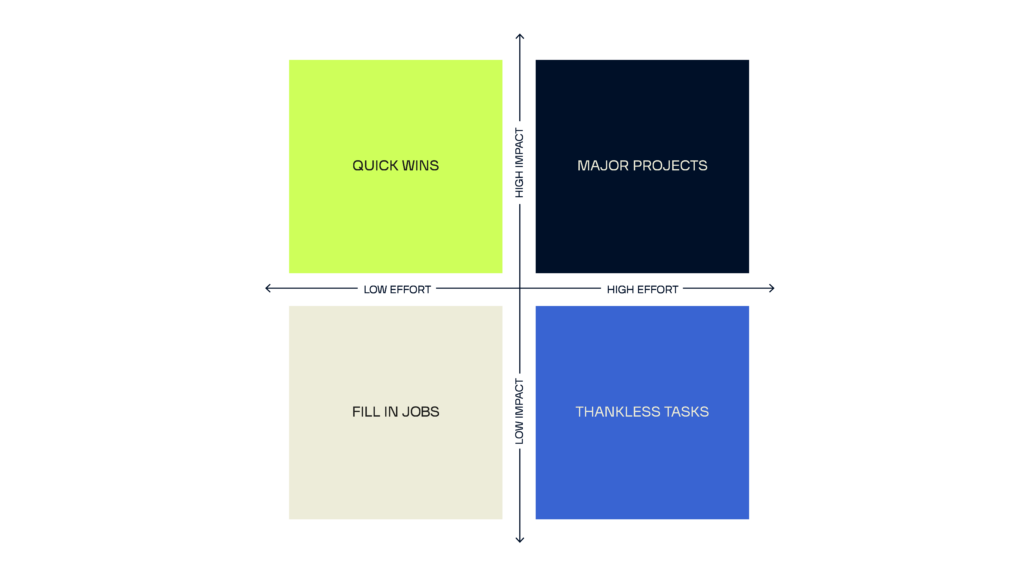Before you invest time and resources into building a prototype, it’s worth validating and refining your ideas—meaning you revise and adapt them based on feedback from your target audience and the insights you’ve gathered. This not only saves effort but also boosts your chances of success.
This section is for you if …
- you’re planning to launch an impact startup or are already working on one with your team.
- you understand your target group and their needs.
- you’ve tested your solution ideas and collected feedback.
- you’ve created an Impact Ladder.

Not quite there yet?
Check out the section that fits your current stage.
In this section, you’ll learn how to …
- confirm or improve your solution ideas.
- sharpen your impact logic and refine your Impact Ladder.
- prioritize your next steps.
Validate your assumptions about your solution ideas
By systematically checking your assumptions and comparing them with insights from interviews, you can sharpen your ideas, set priorities, and develop a clear impact logic. We recommend the following three steps:
1. Group your interview insights by topic
Collect and note down all statements, observations, and quotes from your interviews – either on sticky notes or in a digital format.
Group similar responses and identify recurring themes and patterns. These clusters help you structure your insights, set priorities, and see which ideas resonated most with your audience.
2. Review your assumptions critically
Take a close look at the assumptions you’ve made about your solution. Do the interview responses align with your research and expectations?
3. Refine your impact logic using your Impact Ladder
Use the Impact Ladder you created in “Solution design: Creating a solution that drives real impact“to map the path from problem to solution to impact and ensure that your impact logic is coherent. Supplement and update your Impact Ladder with your validated insights – these impact goals will later guide your impact measurement.
Effort-impact matrix: are your ideas worth implementing?
To see which of your ideas offer the most value for a reasonable amount of effort, use the effort-impact-matrix. This tool is especially helpful for social startups with limited resources. You can estimate impact and effort based on your interview findings and a rough input calculation.

1. Define the X and Y axes
- X‑axis (Effort/feasibility): This measures how difficult an idea is to implement—consider time, cost, required resources, or technical complexity. The scale runs from “high effort/difficult to implement” (right) to “low effort/easy to implement” (left).
- Y‑axis (impact): This represents the potential social impact of your idea, from “low impact” (bottom) to “high impact” (top).
2. Assess and place your ideas
- Evaluate each of your ideas using the two criteria:
- Impact: How much benefit or change could the idea generate?
- Effort/feasibility: How complex, costly, or resource-intensive is it to implement?
- Then, plot each idea on the matrix accordingly.
3. Prioritize your solutions
- Quick wins (top left): High impact, low effort – start here. These ideas are easy to implement and deliver big results.
- Major projects (top right): High impact, high effort. These projects are worth doing, but they need careful planning and significant resources.
- Fill-ins (bottom left): Low impact, low effort – Nice-to-haves if you have extra time or capacity.
- Thankless tasks (bottom right): Low impact, high effort – best avoided; they’re not worth the investment.
.
Next chapter: Build your prototype
Can you clearly define the problem, target group, and expected impact, and back it all up with data? Have you developed a solution idea that’s been well received? Great. Do you also have the financial, technical, and human resources you’ll need?
If so, you’re ready to move on to prototyping .

If not, no worries – go back through the solution design process and revisit “Solution design: Creating a solution that drives real impact”. It’s worth taking the time to build a solid foundation.
Stuck?
Here are some tips to help validate your ideas and impact logic
Find more creative solutions
Use creativity techniques like brainstorming or mind mapping. Look at the problem from different angles by involving more stakeholders. Explore how similar challenges have been tackled in other industries or contexts.
Take an iterative approach
Test parts of your solution before building a full prototype. Use your Impact Ladder to structure these test steps logically – and refine them as you go.
Prioritize key features
Create a ranked list of features based on what matters most to your target group. Focus on the core elements that address the problem most effectively.
Evaluate your ideas more systematically
Define clear criteria to assess your solution ideas. Use a comparison table to objectively evaluate different options, factoring in feasibility, cost, and potential impact.
Shorten your feedback loops
Start gathering feedback earlier – and do it more often. It’ll help you adjust faster and stay on track.
Tips to help you validate the problem and your target group
Analyze the problem more thoroughly
Make sure you truly understand the underlying issue.
. Go deeper with your situational analysis to get a clearer picture of the current state. Revisit and question your original assumptions.
Deepen your understanding of the target group
Conduct more interviews or surveys to gain deeper insights into your target groups’ needs and pain points.
Reassess your goals
Check whether your goals are still relevant and achievable. Define clear, measurable success criteria for your solution ideas.